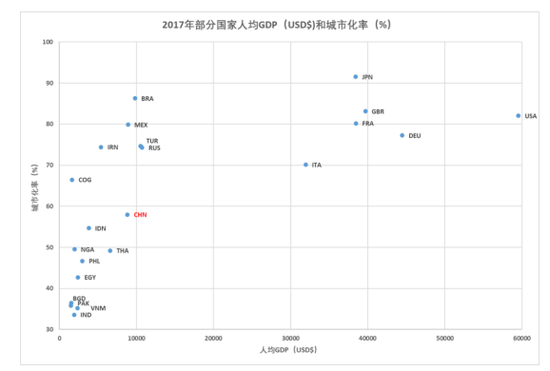Article/Liang Jianzhang, columnist of Sina Financial Opinion Leader Column (WeChat official account kopleader)
Let children in rural areas live with their parents, smoothly enter classes, kindergartens, primary schools, junior high schools, and high schools, and further realize the permanent family migration of migrant workers to cities. This will not only help solve the problem of family reunion of rural left behind people in the short term, but also alleviate the shortage of urban labor market in the medium term, In the long run, it will promote the promotion of China's future generation of human capital, and finally realize China's transformation from a middle-income country to a high-income country.
Compared with rural areas, cities need early education centers more
The quantity and quality of China's human resources is the starting topic of this speech. Liang Jianzhang believes that creativity is constrained by the college entrance examination system, and rural education problems cannot be completely solved, which are two pain points for improving the quality of human resources.
The theme of this forum is early childhood education. The survey results of Scott Rozelle, a Stanford professor who is one of the keynote speakers of this event, show that more than half of rural children do not receive good education when they are 0-3 years old, leading to a decline in their ability to receive high-quality education in the future, which will lead to a greater gap in China's future talent quality and competitiveness.
The solution proposed by Professor Roscoe is to build early education centers in rural areas. The preliminary experimental results show that these early education centers can significantly improve the cognitive ability of rural children.
Compared with the early education worries of rural left behind children, cities need early education centers for children of migrant workers. China's future job opportunities will mainly focus on cities rather than rural areas, and migrant workers will gradually become urban population.
“ If cities cannot provide their children with educational facilities, including early education, the result will be slower urbanization 。” Liang Jianzhang said.
Low urbanization rate is the direct cause of left behind children
Liang Jianzhang believes that China's low urbanization rate is a key issue in China's human resources development and education, and also the direct reason for the excessive number of left behind children in China.
In view of some people's suggestion that expanding the population density and volume of cities will lead to problems such as excessive urban load and insufficient resources, Liang Jianzhang believes that this concern is not only superfluous, but also misleading. Both the economic theory and the practical experience of developed countries have proved that expanding the size of cities is the inevitable path of economic development.
According to the relevant data of the World Bank, China's urbanization rate is less than 60%, which is in the middle and low level in the world. Some countries with high per capita GDP, such as the United States, the United Kingdom and Japan, have reached an urbanization rate of 80% - 90%, while countries with similar per capita GDP, such as Turkey, Russia, Mexico and Brazil, have also reached an urbanization rate of more than 70%, even India, whose per capita GDP is lower than China's, has also exceeded 50%. "It can be seen that China's urbanization rate is far behind China's economic development level," Liang Jianzhang said.
 Data source: World Bank Data, 2017
Data source: World Bank Data, 2017 Compared with the data of Japan and South Korea, about 1/3 of the population of Japan lives in Tokyo; Nearly half of South Korea's population lives in Seoul. Suppose that 1/2 of China's 1.4 billion population is evenly distributed in 20 first and second tier cities, each city can have 35 million people, and if calculated by 1/3, each city can have more than 20 million people. Liang Jianzhang is optimistic that China will have at least dozens of megacities with a population of 120 million in the future.
He emphasized that because of the scale effect in the sense of economics, under the current economic pattern, large cities not only gather innovative talents in the service industry and innovative industries, but also produce a large number of labor-intensive jobs, such as nannies, security guards, decoration workers and drivers. They are all very important to the city. However, at present, the provision of children's education and other social services for migrant workers in cities needs to be improved, which also leads to more people leaving their children in rural areas.
“ Therefore, the consequences of low urbanization rate include not only the high cost of urban life and extremely low urban fertility, but also the instability of migrant workers' families and the lack of early education for left behind children. ”Liang Jianzhang said.
Improving Children's Education Mechanism while Expanding Cities
"Big cities should not restrict the inflow of population, but should increase the investment in land supply, infrastructure and educational facilities. Not only can migrant workers work in big cities, but also their children can receive education in big cities. You should know that to achieve the same level of education, the per capita cost in big cities is much lower."
Let children in rural areas live with their parents, smoothly enter classes, kindergartens, primary schools, junior high schools, and high schools, and further realize the permanent family migration of migrant workers to cities. This will not only help solve the problem of family reunion of rural left behind people in the short term, but also alleviate the shortage of urban labor market in the medium term, In the long run, it will promote the promotion of China's future generation of human capital, and finally realize China's transformation from a middle-income country to a high-income country.
"I appeal to strengthen the research and investment in early education for children of rural and urban migrants, increase the investment in land supply, infrastructure and educational facilities, and let children of migrant workers receive education in big cities," Liang said.
This article comes from the speech of 2018 International Forum on Early Childhood Development.
(About the author of this article: Ctrip co-founder and chairman of the executive board)


